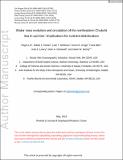| dc.contributor.author | Lin, Peigen | |
| dc.contributor.author | Pickart, Robert S. | |
| dc.contributor.author | McRaven, Leah T. | |
| dc.contributor.author | Arrigo, Kevin R. | |
| dc.contributor.author | Bahr, Frank | |
| dc.contributor.author | Lowry, Kate E. | |
| dc.contributor.author | Stockwell, Dean A. | |
| dc.contributor.author | Mordy, Calvin W. | |
| dc.date.accessioned | 2022-02-16T15:14:03Z | |
| dc.date.available | 2022-02-16T15:14:03Z | |
| dc.date.issued | 2019-06-07 | |
| dc.identifier.issn | 2169-9275 | |
| dc.identifier.issn | 2169-9291 | |
| dc.identifier.uri | https://hdl.handle.net/1721.1/140397 | |
| dc.description.abstract | Synoptic and historical shipboard data, spanning the period 1981–2017, are used to investigate the seasonal evolution of water masses on the northeastern Chukchi shelf and quantify the circulation patterns and their impact on nutrient distributions. We find that Alaskan coastal water extends to Barrow Canyon along the coastal pathway, with peak presence in September, while the Pacific Winter Water (WW) continually drains off the shelf through the summer. The depth-averaged circulation under light winds is characterized by a strong Alaskan Coastal Current (ACC) and northward flow through Central Channel. A portion of the Central Channel flow recirculates anticyclonically to join the ACC, while the remainder progresses northeastward to Hanna Shoal where it bifurcates around both sides of the shoal. All of the branches converge southeast of the shoal and eventually join the ACC. The wind-forced response has two regimes: In the coastal region the circulation depends on wind direction, while on the interior shelf the circulation is sensitive to wind stress curl. In the most common wind-forced state—northeasterly winds and anticyclonic wind stress curl—the ACC reverses, the Central Channel flow penetrates farther north, and there is mass exchange between the interior and coastal regions. In September and October, the region southeast of Hanna Shoal is characterized by elevated amounts of WW, a shallower pycnocline, and higher concentrations of nitrate. Sustained late-season phytoplankton growth spurred by this pooling of nutrients could result in enhanced vertical export of carbon to the seafloor, contributing to the maintenance of benthic hotspots in this region. | en_US |
| dc.language | en | |
| dc.publisher | American Geophysical Union (AGU) | en_US |
| dc.relation.isversionof | http://dx.doi.org/10.1029/2019jc015185 | en_US |
| dc.rights | Article is made available in accordance with the publisher's policy and may be subject to US copyright law. Please refer to the publisher's site for terms of use. | en_US |
| dc.source | Wiley | en_US |
| dc.title | Water Mass Evolution and Circulation of the Northeastern Chukchi Sea in Summer: Implications for Nutrient Distributions | en_US |
| dc.type | Article | en_US |
| dc.identifier.citation | Lin, P., Pickart, R. S., McRaven, L. T., Arrigo, K. R., Bahr, F., Lowry, K. E., et al (2019). Water mass evolution and circulation of the northeastern Chukchi Sea in summer: Implications for nutrient distributions. Journal of Geophysical Research: Oceans, 124, 4416– 4432. | en_US |
| dc.contributor.department | Woods Hole Oceanographic Institution | |
| dc.relation.journal | Journal of Geophysical Research: Oceans | en_US |
| dc.eprint.version | Author's final manuscript | en_US |
| dc.type.uri | http://purl.org/eprint/type/JournalArticle | en_US |
| eprint.status | http://purl.org/eprint/status/PeerReviewed | en_US |
| dspace.date.submission | 2022-02-09T21:06:27Z | |
| mit.journal.volume | 124 | en_US |
| mit.journal.issue | 7 | en_US |
| mit.license | PUBLISHER_POLICY | |
| mit.metadata.status | Authority Work Needed | en_US |
